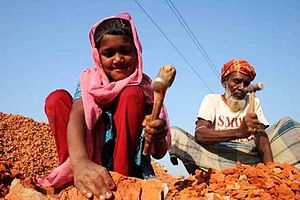 Image via WikipediaSource: ZEENEWS.COM
Image via WikipediaSource: ZEENEWS.COMLast Updated: Sunday, October 09, 2011, 17:54
New Delhi: It has been half a decade since the government prohibited employment of children below 14 years as domestic help, but the ban seems to be on papers only as the "modern-day slavery" still continues unabated across the country, activists say.
Through a notification on October 10, 2006, the Child Labour Prohibition and Regulation Act (CLPRA) specifically prohibited employing children below 14 years in domestic and hospitality sectors.
Five years on, unfortunately child labour in domestic sector, which is tantamount to modern-day slavery, is still rampant, said Thomas Chandy of NGO Save the Children India.
"Just in Kolkata alone, Save the Children estimates that there are over 50,000 child domestic workers who live with the employers. There are thousands more who work in middle-class homes but don't stay with their employer," Chandy said.
Ashok Kumar, National Convener of Campaign Against Child Labour (CACL), said the ban on employing children in domestic and hospitality sectors was a progressive addition to the 1986 Child Labour Act.
"Neither any enforcement mechanism is seen working, nor a comprehensive rehabilitation plan is in place even after five years," Kumar said.
For example, he pointed out, there are about 50,000 child domestic workers in Delhi. Only 23 of them are known to have been rescued till 2009.
"Unless employment of children is made a cognisable offence under the CLPRA, there will be no deterrence for the employers," he said.
However, Dola Mahapatra of NGO ChildFund India said by making laws only we cannot curb these social menaces.
"There needs to be proper infrastructure to ensure the ban is implemented. Besides, awareness and community engagement is highly required to help curb the menace," he said.
The activists also pointed out that the government has no proper enumeration of the children working in those sectors.
While the Census shows a rise in the number of child labourers from 11.3 million in 1991 to 12.6 million in 2001, the National Sample Survey says there has been a decline in their numbers, down from 13.3 million in 1993-94 to 8.6 million in 2004-05.
According to the 2001 Census, 1.86 lakh children below the age of 14 are engaged as child domestic workers, while 70,934 are working in dhabas and other eateries. This brings the number of children to 2,56,439 working in both the domestic and hospitality sectors.
But the real figures could be several times more than what the government estimates show, the activists said.
Children working as domestic help are forced to work long hours, without food and either paid minimal wages or no pay at all.
"This invisibility (of child workers who stay with their employers) is a key reason for their vulnerability to exploitation and physical and psychological abuse," Chandy said.
The activists also demanded that the CLPRA needs to be amended urgently following the enactment of Right to Education (RTE) Act.
"There surely was a sound rationale for the CLPRA to be enacted but that logic is now a 'non sequitur'. You can't have one law that promises elementary education to all children and another one regulating child labour," Chandy said.
"With the RTE is now in place, there just cannot be another law to regulate child labour," Kumar seconded.
If the government is really serious about implementing the RTE, it should not waste more time in amending the CLPRA, the activists said.
PTI


No comments:
Post a Comment